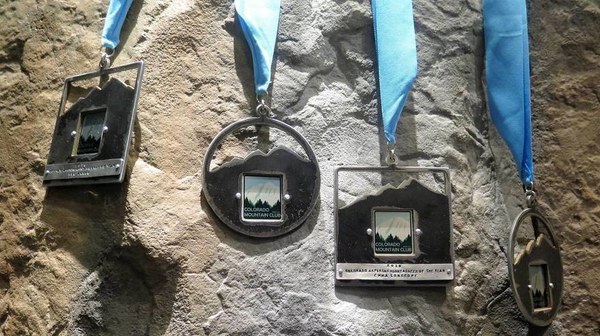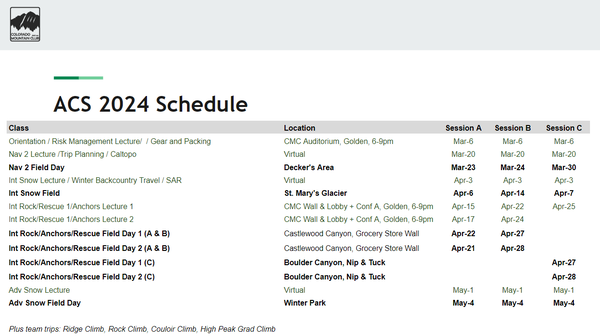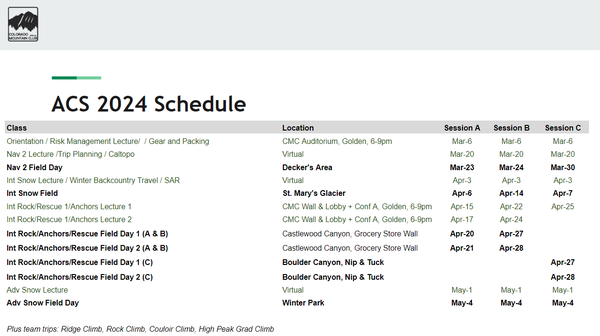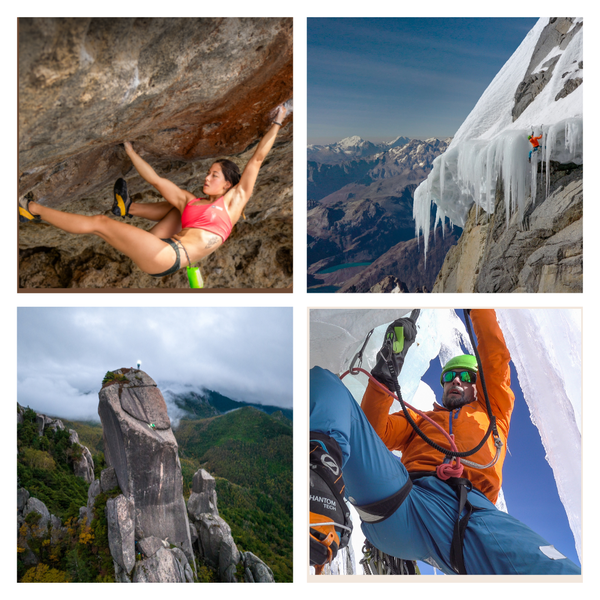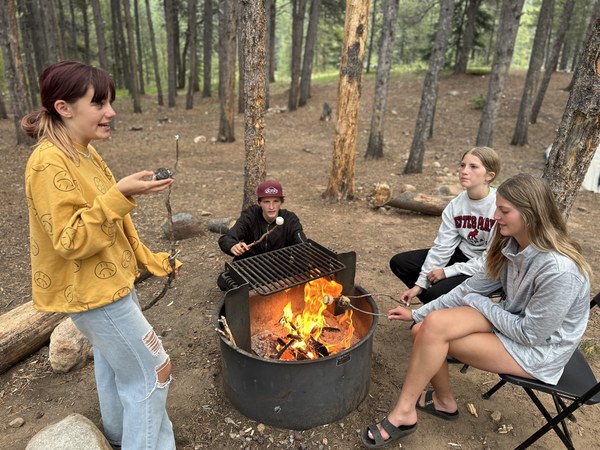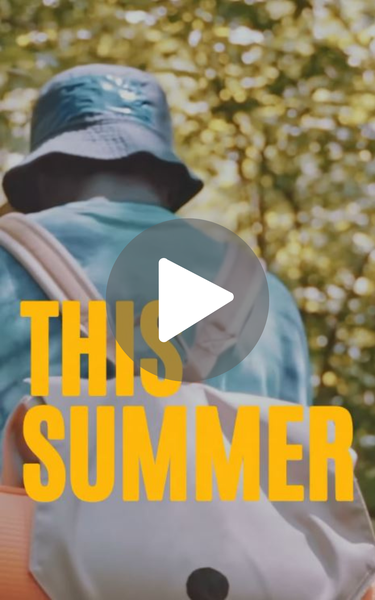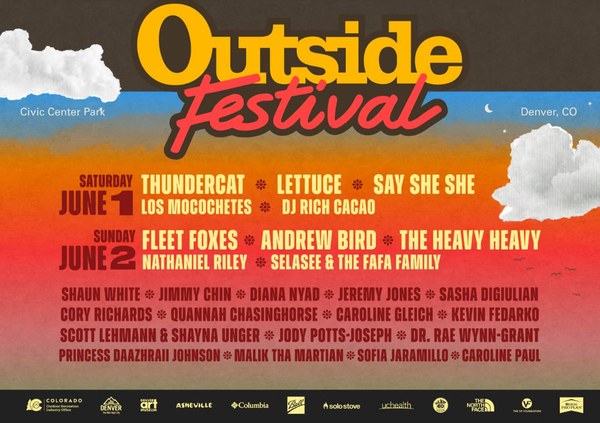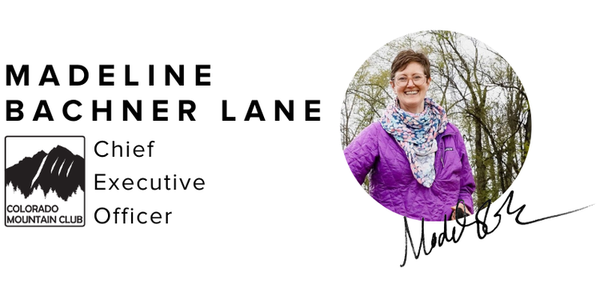CMC
New Fall Hiking Book from CMC Press
Colorado's Best Hikes for Fall Colors, the latest guidebook to be published by CMC Press, describes hikes to 45 of Colorado’s best places to see fall colors.
Order your copy of Colorado's Best Hikes for Fall Colors today!
*****
Ben Tyler Trail
Rating Difficult
Round-Trip Distance 12.5 miles
Elevation Gain 3,700 feet
Round-Trip Time 8 hours
Maps Trails Illustrated 105: Tarryall Mountains, Kenosha Pass
Main Attraction A difficult hike close to the Front Range with views of a huge aspen grove
COMMENT: One of the Front Range’s best hikes for fall color, the Ben Tyler Trail ascends steeply into a massive aspen grove before topping out at a high saddle with sweeping vistas.
GETTING THERE: The Ben Tyler Trail is located 6.8 miles west of Bailey on the south side of US Highway 285. The trailhead is marked by a small brown sign on the south side of the road and is often quite busy.
TRAILHEAD: The Ben Tyler Trailhead has parking for around fifteen vehicles and is very close to the highway. Use caution when leaving the trailhead as traffic on US 285 is moving fast! The trail starts at the east end of the parking shoulder.
THE ROUTE: The trail begins on the edge of the highway and immediately gains 300 feet over the course of twelve switchbacks and 0.4 mile. Above the switchbacks, leave the sounds of the road behind and continue to climb through ponderosa pines before leveling off and traversing more open terrain along a trail flanked by mountain mahogany bushes (look for their incredible curly seed tails in the fall and winter) and offering views of Ben Tyler Gulch above. At 1.3 miles, sign in to the wilderness area at the register box and enter a forested section of trail soon thereafter. At 1.6 miles, the trail nearly touches the creek and offers a junction to some camping options. Do not cross the creek and instead continue uphill.
From here, the trail steepens on often rocky trails before finally crossing the creek at 2 miles. The trail begins to ascend even more rapidly here but soon puts you in a massive aspen grove that can feel like a hallway of yellow leaves from mid-September onward. As the trees periodically open up, you’ll catch glimpses of the other side of the hill covered in aspens.
At 10,580 feet and 4 miles from the trailhead, the first set of switchbacks begins. For the next half mile, you will be rewarded with sweeping views back down the gulch, filled with aspens. After this, the trail goes from a “moderate” endeavor to a “difficult” one, and the aspen show fades into the background in favor of an approach to the tundra. Turn back if you were only in it for the fall colors or continue if you want the alpine views.
The second of three sets of switchbacks begins at 4.8 miles, and the trail meets up with the Craig Park Trail at 5 miles. Stay to the right to continue climbing the Ben Tyler Trail. Traverse the final set of switchbacks at 5.5 miles, winding through bristlecone pines before emerging onto the alpine tundra at the 6-mile mark. The rolling saddle offers views of South Park and the Collegiate Peaks to the southwest and Mounts Evans and Bierstadt to the north. Return the way you came.
I rated this trail “difficult” because of the steep climbs in the middle of the hike. The terrain is often rocky and loose. Routefinding above tree line can get slightly complicated as multiple social trails crisscross the landscape and official trails branch off to other parts of the wilderness area. The round-trip hike is lengthy and requires you to assess the fitness and stamina of the group.
If you are looking to make a fantastic day hike into a backpacking trip, this is an ideal option that can combine multiple colorful hikes into a single adventure. Combine the Ben Tyler Trail up over the Kenosha Mountains. From the top of this hike, it is possible to descend Ben Tyler Gulch on the south side of the mountains until it meets the Colorado Trail. Continue west to the Kenosha Pass hike listed in Hike 5. Stationing one car at Kenosha Pass and another at the Ben Tyler Trailhead would make an easy point-to-point 17.8-mile hike that combines two fantastically colorful hikes close to the Front Range.
Backcountry Film Fest - MONTROSE
| $15.00 | 34 (40 capacity) | |
| $18.00 | 46 (60 capacity) |
Backcountry Film Fest - SALIDA 1/31
| $15.00 | 25 (25 capacity) | |
| $18.00 | 68 (175 capacity) |
Backcountry Film Fest - COLORADO SPRINGS 2/15
| $15.00 | 26 (40 capacity) | |
| $18.00 | 44 (60 capacity) |
Backcountry Film Fest - GOLDEN 3/29
| $15.00 | 120 (140 capacity) | |
| $18.00 | 198 (200 capacity) |
Teen Summer Courses: A Place to Make Friends, Build Confidence, and Connect Offline
Teens today have a world of connection at their fingertips, yet many feel lonelier than ever. “Loneliness is a scary thing happening in society, and teens are at high risk for it,” explains Stacey Halvorsen, Colorado Mountain Club’s Chief Education Officer. “We’ve done screenings for it for some of our teen programs, and we’ve seen that there’s a prevalence amongst the teens we’re working with.” Despite online connection and constant social media use, which can have negative mental health impacts, teens report feeling alone or having a lack of friends. Between that, the pressure to succeed in school, and the tidal wave of emotions that come with growing up, these years are especially challenging.
The stress of growing up is unavoidable, but spending time in nature with peers can be a great way to mitigate that. CMC’s Youth Program offers several overnight, day, and multi-day courses. The programs geared towards teens take them to outdoor destinations both in and outside of Colorado where they get to experience a controlled independence and practice building self-confidence and resilience that will benefit them for their entire lives.
“Teens in our courses learn a lot about how to take care of themselves,” says Alec Backhus, Youth Program Coordinator. “They learn how to cook for themselves, feed themselves, and get themselves up at the right time in the morning.” It’s a level of responsibility that many teens don’t have at home but will need to know for successful, independent lives. Another important responsibility? Being able to make decisions with a group. “Our instructors are skilled at including students in decision making,” says Halvorsen. “It's 12:00, and the weather's coming in. Do we keep climbing, or do we go back to camp? What are our choices? What are our options? What information do we need to make an effective decision that manages risk and takes the safety of the group into account?” By including the teens in those important decisions, leaders enable the students to build self-efficacy skills that will help them make thought-out choices in all aspects of their lives.
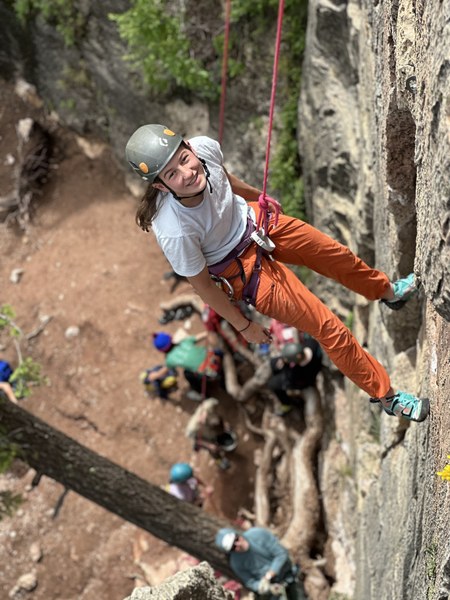
CMC’s teen summer courses also give them a hands-on chance to practice valuable people skills in a controlled environment. “Kids meet new people and make new friends, often branching out of who their typical friend group might be. Many don't even have a typical friend group,” explains Backhus. “Doing a climbing trip or something where they're with a bunch of people they might not normally hang out with but who they share this hobby or interest really helps them build out their social skills. I think it really increases their self-confidence and self-reliance quite a bit.”
While there are skill requirements for some courses, many of CMC’s teen courses are open to anyone willing to try something new. “One of our number one goals is to take people who are nervous or are scared or haven't tried these things and show them that they are capable of it,” reassures Backhus. “Yes, you might need a special skill set, but it's something that you can learn and something that we can teach you.”
CMC’s Teen Courses are open for enrollment but are closing soon. Here are some courses where we still have space available:
Upcoming Overnight Courses:
- INTERMEDIATE/ADVANCED ROCK CLIMBING - SHELF RD - GRADES 9-12
- INTERMEDIATE/ADVANCED ROCK CLIMBING - PENITENTE - GRADES 9-12
- BACKPACKING - FLAT TOPS WILDERNESS - GRADES 9-12
- MOAB ADVENTURE - ROCK TO RIVER - GRADES 8-12
Upcoming Day Course:
Upcoming Multi-Day Course:
Taking an outdoor course is an excellent way to meet friends with common interests, learn new skills, and build resilience by stepping outside your comfort zone. These experiences not only help teens grow as people, but they also look great on college applications.
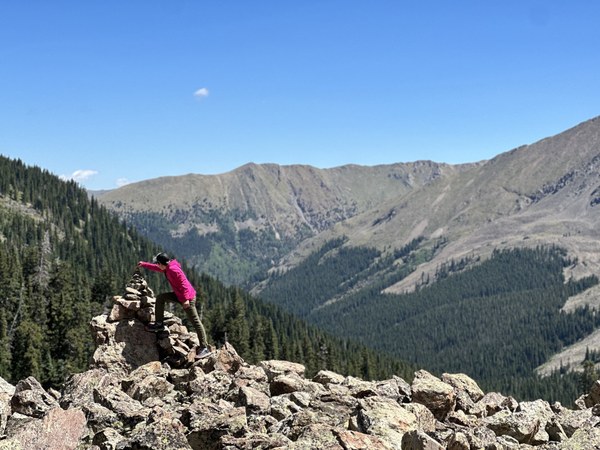
“Students in our courses get to connect with themselves but also with nature and their peers,” explains Halvorsen. “They’re doing something physically active, which is good for their bodies and brains. Being in nature has mental health benefits from being in green space, and teambuilding and teamwork lets them connect deeply with their peers. They get to know other people and how to work with them, and they get to know themselves.”
If cost is a concern, financial assistance and scholarships are available. Feel free to reach out to yep@cmc.org for more information or to ask any questions you have about what summer courses entail. Members of the CMC Youth Education staff is happy to talk things through and help you figure out which course is right for you or your teen.
Enter to Win Tickets to Outside Festival!
Kick-off the summer with an epic lineup of music, incredible films, and inspiring speakers at Outside Festival on June 1-2, 2024, at Civic Center Park in Denver, CO!
This is going to be a weekend celebrating all things outdoors, and we're giving away a pair of 2-day tickets!
Member Perk: Every CMC member gets an additional ticket entry! (If you're not a member but ready to join the club, sign up here.)
ENTER TO WIN TICKETS
Giveaway ends May 23, 2024 at 11:59PM MT. One entry per person. Multiple entries will be discarded. Membership not required for entry.
Action Alert: Winter Travel Planning Begins on the Rio Grande National Forest
This post is shared from our partner Winter Wildlands Alliance. Click here to see their original post.
It may be spring, but in southwest Colorado, we are excited about winter travel planning! The Rio Grande National Forest recently began a winter travel planning process that will ultimately designate routes and areas for over-snow vehicle (OSV) use across the 1.8-million-acre Rio Grande National Forest.
Why is winter travel planning on the Rio Grande important?
From the deep snows of Wolf Creek Pass to the high peaks of the Sangre de Cristo Range, the Rio Grande supports a wide range of winter recreation opportunities. Rare, endangered lynx also roam the Rio Grande’s snowy forests. This winter travel plan is our chance to protect quiet recreation and wildlife on the Rio Grande by better managing OSV use.
What is being proposed?
On April 30, the Forest Service published a Proposed Action and Notice of Intent to Prepare an Environmental Impact Statement (EIS) for this project. The agency is proposing to designate 74% of the Rio Grande (1,382,276 acres) for OSV use, along with 260 miles of groomed OSV routes. Read the Proposed Action on the Forest Service project page here.
The Proposed Action that the Rio Grande has provided is just a starting point based on Winter Recreation Opportunity Spectrum (ROS) maps that the forest recently published. These maps zone the forest for desired recreational settings, including suitability for motorized use. Importantly, there is a distinct difference between ROS mapping and motorized use designations. ROS mapping defines which areas can be considered for OSV designations (Rural, Roaded Natural, and Semi-Primitive Motorized are all settings where OSV use is suitable). Before designating any areas for OSV use within these ROS zones, the Forest Service must conduct a site-specific environmental review taking into account impacts to wildlife, natural resources, and other recreational uses. This environmental review is travel management planning.
What’s happening now?
We are in the initial phase of the travel planning process (scoping) where the public can provide input on the proposed action and suggest alternatives. During scoping, the Forest Service seeks comments from the public to identify key issues and concerns.
This feedback helps the Forest Service develop multiple alternatives based on the comments received and other information gathered during this scoping period. The final plan will be based on these alternatives and the Proposed Action.
Why is the Proposed Action concerning?
The Rio Grande’s Proposed Action is unacceptable for several reasons.
- Compliance Issues: It does not comply with the Over-Snow Vehicle Rule’s “closed unless designated open” requirement. This rule mandates that national forests are closed to OSV use outside of specifically designated areas.
- Intensive OSV Use: Instead, the Rio Grande is proposing to designate almost all of the non-Wilderness lands on the forest for OSV use without adequately minimizing, or even considering site-specific impacts to wildlife and natural resources or conflicts with other uses.
- High-Value Non-Motorized Areas: It is concerning that the vast majority of non-Wilderness lands on the forest are proposed to be designated for OSV use, including high-value non-motorized areas and places with longstanding use conflict.
- Snow Depths: We support the Rio Grande’s proposal to require at least 12 inches of snow for OSV use to help protect natural resources. This 12 inch minimum, adopted by forests in California where OSV planning has occurred, has a solid rationale. However, given that the snow on the Rio Grande is generally lighter and drier than in the Sierras, we think it is important that the Forest Service analyze deeper options for minimum snow depths, to ensure the minimum snow depth achieves the intended purpose.
How can we learn from the past experiences?
We look forward to applying the lessons we have learned from nine years of winter travel planning in California to the Rio Grande’s planning process. We aim to incorporate management priorities that we have learned from partners and locals who live and ski on the Rio Grande.
How can you get involved?
This scoping comment period is your opportunity to tell the Forest Service what matters to you regarding winter travel management on the Rio Grande.
If you visit the Rio Grande in the winter, it is crucial you share your experiences and priorities in a comment letter. The Forest Service must minimize OSV impacts to wildlife and natural resources and minimize conflicts between OSV use and other uses.
Even if you have never been to the Rio Grande, you can still submit a substantive comment letter. Comment letters that share ideas for how the Forest Service can meet these requirements are also very helpful.
How can you comment?
We have put together a simple comment letter for you to sign on to, highlighting Winter Wildlands Alliance’s priorities.
You can also submit your own comment letter online using the Forest Service’s CARA form. If you recreate on the Rio Grande, we encourage you to describe the specific places that you think should or should not be designated for OSV use and how you think these places should be managed. If you have experience with OSV management or planning elsewhere, sharing advice from that experience is also very helpful.
If you draft your own letter, consider including and elaborating on the following points:
- Compliance with the OSV Rule: The Proposed Action is not in compliance with the Over-Snow Vehicle Rule’s “closed unless designated open” framework. All alternatives developed for this EIS must designate and analyze discrete, delineated OSV areas.
- Minimizing Conflict: To minimize conflicts between OSV use and other winter recreation uses (skiing, snowshoeing, etc.), the Forest Service must consider snow quality, noise impacts, air quality, and public safety. The final OSV plan should not designate high-value non-motorized recreation areas, such as Nordic ski trails and terrain around backcountry huts or adjacent to ski areas, for OSV use. Important quiet winter recreation areas on the forest include:
- Big Meadows Ski Trail
- Rock Creek Ski Trail
- Lime Creek Trail
- Neff Mountain, near Cumbres Pass
- Lobo Peak, on Wolf Creek Pass
- Terrain surrounding the Spruce Hole Yurt
- Terrain surrounding the Pass Creek Yurt
- The “Matchless” area adjacent to the Wolf Creek Ski Area
- Big Meadows Reservoir Area, south of Forest Road 410
- Wildlife Protection: To minimize impacts to wildlife, the Forest Service should follow recommendations from Colorado Parks and Wildlife pertaining to big game winter activity areas, winter wildlife areas, and riparian/wetland areas. The plan must also comply with the Southern Rockies Lynx Amendment.
- Minimum Snow Depth: Support using a minimum snow depth as a means to minimize impacts to natural resources. The EIS should also analyze a deeper minimum snow depth to determine if the proposed 12” is sufficient to protect subnivean habitat, soils, and vegetation. The EIS must also consider how OSV use will affect natural resources that may not be protected by a minimum snow depth, such as water quality and trees.
- Enforcement: Enforcement should be a consideration from the start of this planning process. The EIS should describe how the Rio Grande will implement and enforce the final plan. Designated OSV boundaries should follow obvious physical or topographic features like plowed roads or ridgelines.
Celebrate the Start of Summer with a CMC Press Sale
Summer is here and to celebrate, Colorado Mountain Club is offering a 30% discount on select summer guidebooks now through July 11th! Whether you're planning an adventurous hike, a sightseeing stroll, or a backpacking trip with the whole family, CMC Press has the perfect guidebook to help you make the most of your summer adventures. Stock up on knowledge and save at the same time – it's the perfect excuse to dive into summer planning!
Use code SUMMER24 to get 30% off the following titles:
- Colorado Campgrounds, 5th edition
- Wild Eats
- Hiking Safety Handbook
- Backpacking with Children
- Colorado Trail, 10th edition
- Colorado Waterfall Hikes, 2nd edition
- Colorado Wildflowers: Montane Zone
- Best Southern Front Range Hikes
- The Trad Guide to Joshua Tree
- Best Urban Hikes: Boulder
- Rocks Above the Clouds
- Hiking Colorado's Roadless Trails
- The Essential Guide to Great Sand Dunes National Park and Preserve
- Skiing & Sleeping on the Summits: Cascade Volcanoes of the Pacific Northwest
- Roof of the Rockies
- Playing for Real: Stories from Rocky Mountain Rescue
- Comanche Peak Wilderness Area: Hiking & Snowshoeing Guide
- The Essential Guide to Black Canyon of the Gunnison National Park
- The Best Indian Peaks Wilderness Hikes
Reminder: Colorado Mountain Club members get 20% off all CMC Press books! Log in to your account for your discount.
Featured Summer Sale Titles |
|
|
|
|
|
Teen Moab Rock to River Course Recap
The 5-day trip took participants from our offices in Golden down to Moab, stopping to boulder in Big Bend. We visited Arches National Park, did some crack and slab climbing at “The Ice Cream Parlor” in Kane Creek Canyon, rafted down the Colorado River, and created memories that will last a lifetime. It was such an amazing group of kind, thoughtful, intelligent teens, and we can't wait to see what they go on to accomplish in the outdoors. Curious about what our youth overnight trips are like? Youth Program Coordinator Alec Backhus shared a full recap of the trip below.
Monday
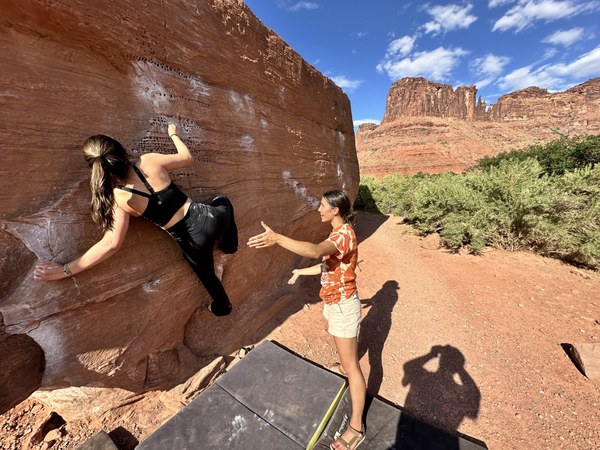
Tuesday
Tuesday morning, we woke up bright and early to beat the heat! We had a quick breakfast at camp and made it into Arches National Park by 6:45am! We hiked the Devils Garden Loop Trail, a 7-mile loop that goes through the heart of the park. We took several side trails and did some exploring of our own, scrambling some rocks to find a pretty view. When all was said and done, we hiked about 10.5 miles and saw eight arches! By the time we were done hiking, the sun was high in the sky and the weather was hot. We took a quick 0.25-mile hike to Sand Dune Arch (our 9th arch of the day), a beautiful arch hidden in a shady slot canyon. We relaxed in the soft sand under the shade of the arch for almost two hours, which provided us instructors a nice break while the kids enjoyed the opportunity to bond and spend time together. We headed back to camp where we cooked dinner and did some slacklining. We then continued the tradition of scrambling the rocks near our camp to watch the sunset.
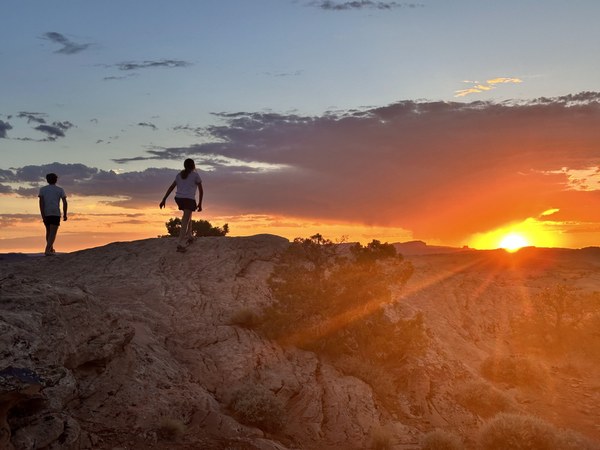
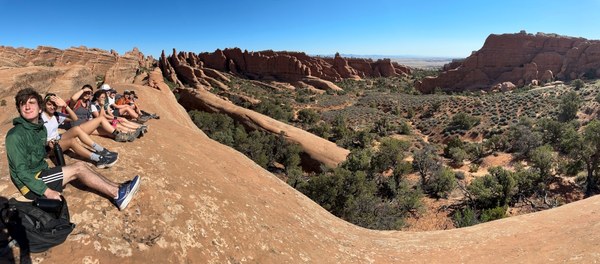
Wednesday
Wednesday was another early start; we left our campsite by 6am and drove into Kane Creek Canyon for some rock climbing at “The Ice Cream Parlor”. The shade provided the perfect climbing conditions and we put up three routes for participants. A 5.8 crack climb, a 5.10 crack/face climb, and a 5.10 slab climb. Our experienced climbers shared their talents and helped the instructor’s belay in addition to climbing. I was so impressed with all our first-time climbers, they showed a willingness to learn, a desire to try hard even after failing, and a natural talent for climbing. Overall, everyone had a blast climbing. We had shade until about 1pm; at that point the sun came over the top of the canyon and we knew it was time to head out! We beat the heat by heading to the Moab Recreation Center pool. We enjoyed the water slide/lazy river, and students continued to face their fears on the diving boards! Once back at camp, we cooked dinner, enjoyed another sunset, and roasted marshmallows around the campfire.
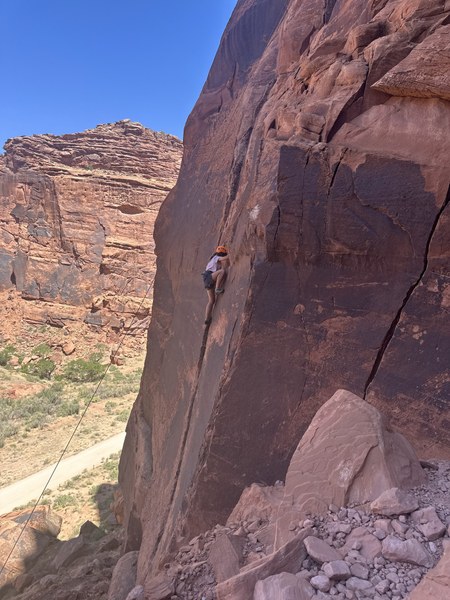
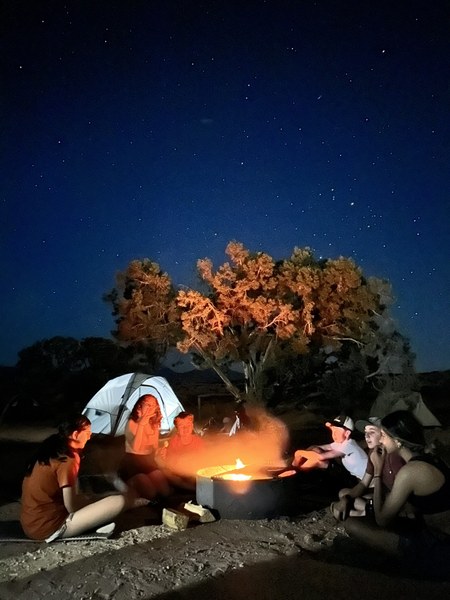
Thursday
Thursday morning was our first chance to sleep in a little, we had a slower morning cooking breakfast and hanging out before heading out to raft! We rafted about 14 miles of the Colorado River -- high water levels offered big fun in the rapids, and plenty of opportunities to jump out of the boat and swim in the flat water. Our guides taught us the history of the land and pointed out a family of nesting bald eagle, some geological features, and even a movie set. Everyone enjoyed their time on the water and had a blast swimming and paddling. After rafting, we did a short hike down Moonflower Canyon to a beautiful, shaded pond. We spent about two hours enjoying the pond, napping, relaxing, and bonding before heading out. (We even got to see some petroglyphs!). Thursday night, we watched our last sunset together at camp. That night we had a beautiful debrief. We all sat in a big circle and took turns going into the middle, and we would all then say one nice thing about the person in the center before switching. The teens were so genuine, kind, thoughtful, and vulnerable. The moment was meaningful and is one I will never forget as an instructor.
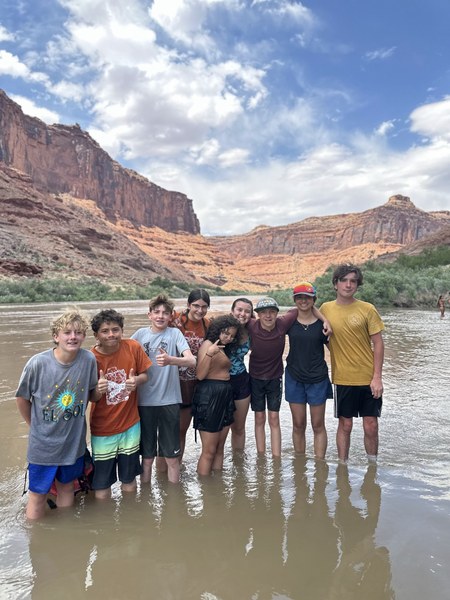
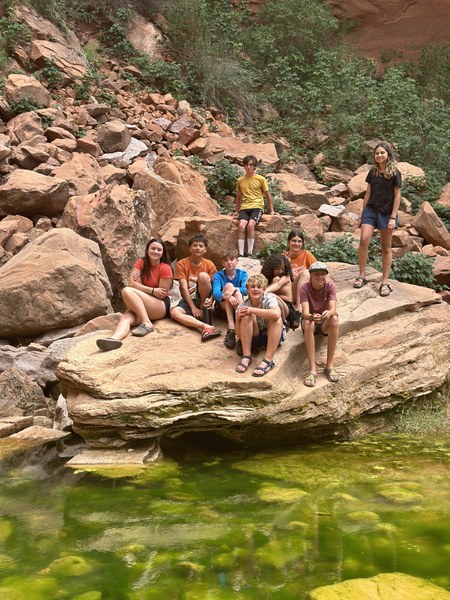
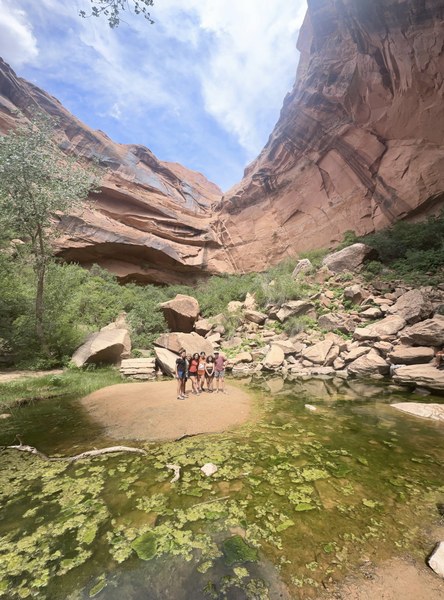
Friday
Friday, we woke up early to break down camp. The night before was too windy for a campfire, so we had one Friday morning. Instructors cooked a pancake breakfast for the teens while they roasted some breakfast s'mores over the campfire! After enjoying our last moments in camp together, we loaded up the van and headed into town for a quick stop at the souvenir shop. We hit the road and soaked in the last of the Utah’s southeastern sandstone as we drove back down Highway 128. Participants exchanged information and enjoyed their last moments together as a group as we drove home. It brought me great joy to hear the laughter, and vibrant conversations happening in the back seats. A group who had only met five days prior had become the closest of friends and bonded over experiences they won’t soon forget.
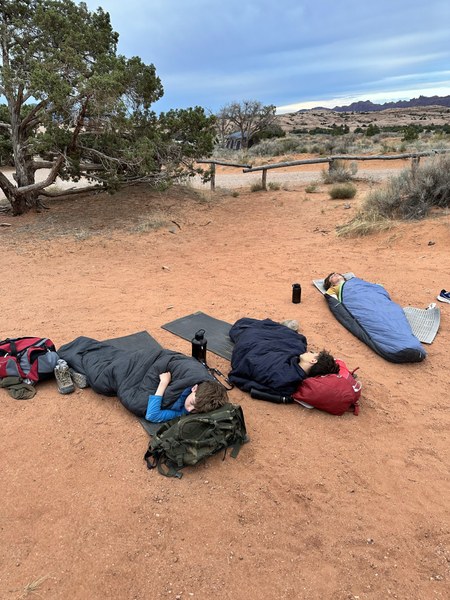
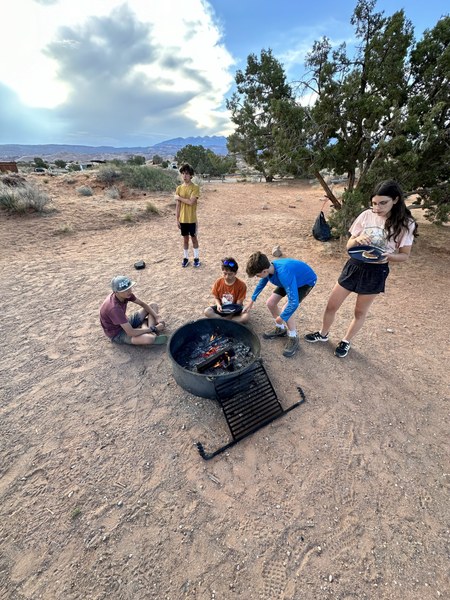
Stay up-to-date with all of our youth programming camps and courses at www.cmc.org/youth.
CMC Members Help Rescue Stranded Hiker
Imagine this: You're on a weekend hike enjoying the solitude and beauty of nature when you stumble upon a fellow hiker in distress. Lost, injured, and alone, they're facing a perilous situation. Would you know what to do?
This is exactly what happened to two Colorado Mountain Club members on a recent hike. Thanks to Wilderness First Aid training and experience as trip leaders and course instructors, they became a lifeline for a hiker who had been injured and stranded overnight on Chicago Lakes trail, providing critical care until the Alpine Rescue Team arrived.
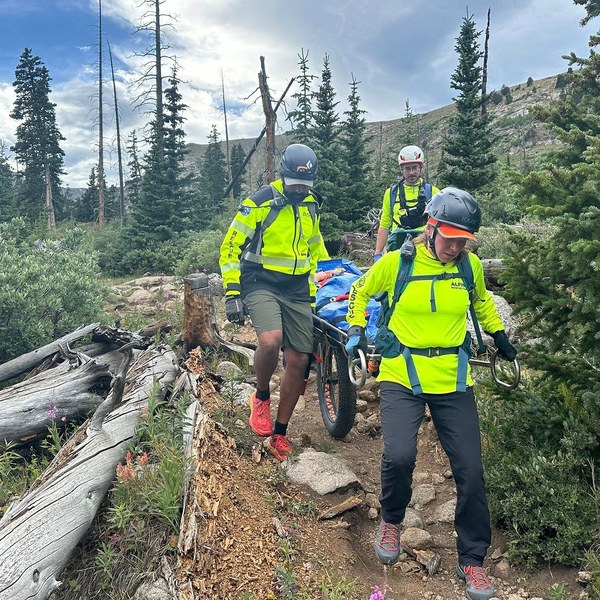
One of the members shared some details from the experience: "On Sunday, August 4th, we hiked Echo Lake to Summit Lake near Mt. Blue Sky and back. On our way back down, we encountered a man who asked for directions. In talking to him, we realized he needed help. He had been out overnight unintentionally, after getting off route. He was far from his vehicle. We offered to walk him to one of our cars at Echo Lake and drive him to Denver. It became clear that he could not hike out, so we conferred and decided it was time for Plan B. We moved a bit farther down trail to get into the trees (it was thundering). We rigged a shelter and hit the SOS button on my Garmin InReach. We gave the subject emergency bivy’s to wrap up in and continued to assess his mentation and keep him talking while we waited about two hours for the first rescue team to arrive. The Alpine Rescue Team came, took over, and determined the patient had to be carried out."
Their story is a powerful reminder of the importance of being prepared for the unexpected in the outdoors. Wilderness First Aid training can mean the difference between life and death for you or someone whose path you happen to cross. As stated in the Alpine Rescue Team's post about the incident, "Be prepared when in the backcountry. Not only for your own personal safety, but in order to help others in need. Thank you to both of them!"
If you're interested in learning how to be prepared for emergencies on the trails, we have two courses you can take based on how in-depth you want to go. Wilderness First Aid (WFA) is a weekend long course that covers environmental, medical, and traumatic injuries with a focus on inclusive care and rescue, patient, and bystander mental health. Wilderness First Responder (WFR) offers a deeper dive into wilderness medicine intended for outdoor professionals who volunteer or work multi-day trips in a backcountry setting. The curriculum forces students to think creatively, adapt to ever changing situations, and learn valuable leadership, decision making, and communication skills.
If you'd like to learn more and sign up for either course, we have several upcoming classes with space still available.
